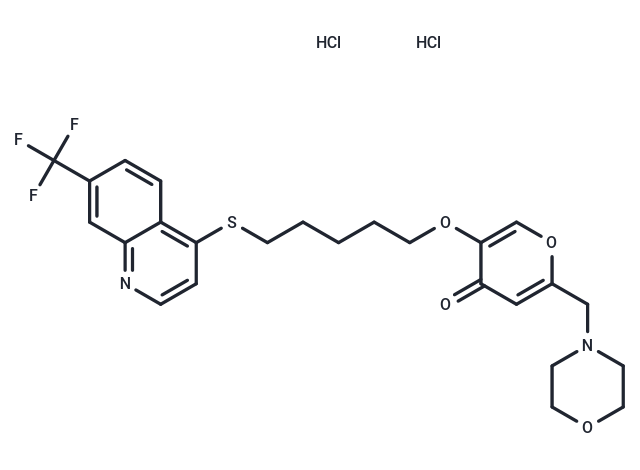Shopping Cart
Remove All Your shopping cart is currently empty
Your shopping cart is currently empty
EHT 1864 (EHT 1864 2HCl) is a Rac family GTPase inhibitor that blocks activation by direct binding to Rac1, Rac1b, Rac2, and Rac3 (Kd=40/50/60/250 nM). EHT 1864 inhibits Rac, Ras, and Tiam-induced growth transformation of NIH-3T3 fibroblasts.

| Pack Size | Price | USA Warehouse | Global Warehouse | Quantity |
|---|---|---|---|---|
| 1 mg | $37 | In Stock | In Stock | |
| 5 mg | $80 | In Stock | In Stock | |
| 10 mg | $131 | In Stock | In Stock | |
| 25 mg | $211 | In Stock | In Stock | |
| 50 mg | $403 | In Stock | In Stock | |
| 100 mg | $607 | In Stock | In Stock | |
| 1 mL x 10 mM (in DMSO) | $103 | In Stock | In Stock |
| Description | EHT 1864 (EHT 1864 2HCl) is a Rac family GTPase inhibitor that blocks activation by direct binding to Rac1, Rac1b, Rac2, and Rac3 (Kd=40/50/60/250 nM). EHT 1864 inhibits Rac, Ras, and Tiam-induced growth transformation of NIH-3T3 fibroblasts. |
| Targets&IC50 | Rac1:40 nM(Kd), Rac1b:50 nM(Kd), Rac2:60 nM(Kd), Rac3:250 nM(Kd) |
| In vitro | METHODS: U87-MG cells were treated with EHT 1864 (10-25 µM) for 5 min and the levels of activated Rac1 or RhoA were measured by pull-down. RESULTS: EHT 1864 strongly inhibited the ability of Rac1 to interact with its effector Pak1 in a dose-dependent manner. In contrast, EHT 1864 did not affect the activation state of RhoA even at the highest dose tested (25 µM). [1] METHODS: Mouse fibroblasts NIH 3T3 were treated with EHT 1864 (5 µM) for 4 h. Cultures were then stimulated with PDGF, LPA, or bradykinin for 15 min, fixed, and visualized for the actin filaments using Alexa phalloidin. RESULTS: PDGF, LPA and bradykinin were effective in inducing membrane wrinkling and lamellipodia formation, actin stress fibers and filamentous pseudopods, respectively. However, in the presence of EHT 1864, PDGF-induced lamellipodia formation was completely blocked, although LPA and bradykinin still induced their respective changes in actin cytoskeletal organization. EHT 1864-treated cells showed an approximately 80% reduction in lamellipodia stimulation by PDGF. [2] |
| In vivo | METHODS: To test the antitumor activity in vivo, EHT 1864 (100 mg/kg) was injected intraperitoneally twice daily for two weeks into NSG mice bearing BT-474 xenografts. RESULTS: EHT 1864 significantly slowed down tumor growth, with an average weekly growth rate of 50% vs. 27%. EHT 1864 greatly reduced the levels of P-ERK1/2, P-AKT, P-p70S6K, and P-Histone H3S10 (mitotic markers). [3] |
| Kinase Assay | Inhibitor:GTPase binding analyses: For inhibitor:GTPase binding analyses, aliquots of small GTPase solution (containing 1 μM inhibitor) are titrated into a solution of 1 μM inhibitor in the cuvette. Changes in fluorescence anisotropy are monitored at λex = 360 nm, λem = 440 nm, 30 s after each addition. All data analysis and curve fitting were performed using Microsoft Excel and QuantumSoft's ProFit for Mac OS X. |
| Cell Research | NIH 3T3 cells stably expressing oncogenic Ras are plated in 96-well plates. The cells are cultured for up to 4 days in complete growth medium, either alone, or supplemented with 5 μM EHT 1864. Cell growth is then assessed using the conversion of MTT to a formazan product. Briefly, the MTT reagent (from a 5 mg/ml solution diluted in PBS) is added to the wells at a final concentration of 0.5 mg/ml, and the cells are further incubated for 4 h at 37°C. The medium is then removed, and the reaction is terminated by adding 100 μl/well Me2SO. The absorbance is read at 570 nm using a microplate reader.(Only for Reference) |
| Molecular Weight | 581.47 |
| Formula | C25H29Cl2F3N2O4S |
| Cas No. | 754240-09-0 |
| Smiles | Cl.Cl.FC(F)(F)c1ccc2c(SCCCCCOc3coc(CN4CCOCC4)cc3=O)ccnc2c1 |
| Relative Density. | no data available |
| Storage | Powder: -20°C for 3 years | In solvent: -80°C for 1 year | Shipping with blue ice/Shipping at ambient temperature. | |||||||||||||||||||||||||||||||||||
| Solubility Information | DMSO: 61.25 mg/mL (105.34 mM), Sonication is recommended. H2O: 58.2 mg/mL (100.09 mM), Sonication is recommended. | |||||||||||||||||||||||||||||||||||
| In Vivo Formulation | 10% DMSO+40% PEG300+5% Tween 80+45% Saline: 2 mg/mL (3.44 mM), Sonication is recommended. Please add the solvents sequentially, clarifying the solution as much as possible before adding the next one. Dissolve by heating and/or sonication if necessary. Working solution is recommended to be prepared and used immediately. The formulation provided above is for reference purposes only. In vivo formulations may vary and should be modified based on specific experimental conditions. | |||||||||||||||||||||||||||||||||||
Solution Preparation Table | ||||||||||||||||||||||||||||||||||||
H2O/DMSO
| ||||||||||||||||||||||||||||||||||||
| Size | Quantity | Unit Price | Amount | Operation |
|---|

Copyright © 2015-2025 TargetMol Chemicals Inc. All Rights Reserved.